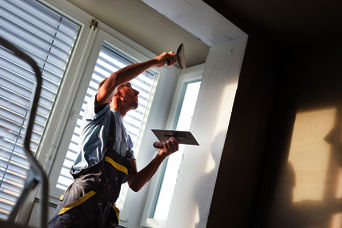Choose gap fillers that ensure healthy living
When removing wallpaper in the course of renovation, sometimes drill holes, stress cracks or serious plaster damage become apparent. And when removing old floor coverings, holes, joints and other unevenness may be found. You have no other choice but to do some patch and repair work to produce smooth surfaces on walls, floors and ceilings. This is best done with solvent-free levelling compounds.
Tip 1: Different levelling compounds for different applications
If, during construction or renovation, uneven areas appear in the masonry or on the floor, these must be levelled out. You can choose from a range of different fillers, depending on the area of application and extent of damage. Fillers of stiff consistency, for example, are used to fill holes and cracks. On uneven floors, fillers should be flowable so that they can easily spread over the surface.
Tip 2: Indoors or outdoors – moisture makes the difference
Gaps or other defects found in outdoor areas or wet rooms require cementitious fillers due to the presence of moisture. In dry indoor areas, pH-neutral fillers are mostly used that contain a high amount of gypsum. They do not tolerate moisture, but can be used for repairing all kinds of damage. Depending on the application, there is also stucco and joint plasters or adhesive fillers for smooth substrates. Synthetic resin fillers are suitable for indoor and outdoor use on all substrates.
Tip 3: Maximum indoor health with EMICODE® products
In order to ensure healthy living and an emission-free room climate, you should prefer levelling compounds that carry the EC1 seal. For more than 20 years, GEV EMICODE® has been testing and certifying building and installation products like adhesives and fillers with respect to their emissions. The label helps you choose building and renovation products that are compatible with your health.

@kasto/123RF.com
Share article on Social Media:
